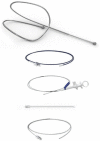The Efficacy of Lung Volume Reduction Coil Treatment in Patients with Severe Chronic Obstructive Pulmonary Disease (COPD) Type II Respiratory Failure
- PMID: 32184585
- PMCID: PMC7060769
- DOI: 10.2147/COPD.S218785
The Efficacy of Lung Volume Reduction Coil Treatment in Patients with Severe Chronic Obstructive Pulmonary Disease (COPD) Type II Respiratory Failure
Abstract
Purpose: Emphysema is a progressive and irreversible disease, proceeding with the decrease in elastic recoil which is connected to tissue damage caused by chronic inflammation. Lung volume reduction coil (LVRC) method in patients with an advanced level of emphysema and irresponsive to medical treatment is shown to provide increase in lung volumes and exercise capacity, decrease in dyspnea, and increase in quality of life. The purpose of this study is to reveal that LVRC treatment is also efficient in severe COPD patients with hypercapnic respiratory failure.
Patients and methods: Eleven cases with severe COPD and emphysema were included in the study. LVRC treatment method was applied in upper lobes of both lungs in patients with severe COPD (FEV1 < %45) and Type-2 respiratory insufficiency (PCO2 55-80 mmHg) who were having medical treatment and CPAP treatment. The patients were followed up for a period of twelve months using arterial blood gas analysis.
Results: Beginning with the first month of the LVRC treatment, PCO2 levels were found to be significantly decreased in all patients using arterial blood gas analysis.
Conclusion: LVRC method can provide physiological and functional recovery and progress in quality of life in severe COPD cases. It is demonstrated that LVRC treatment caused significant decreases in carbon dioxide levels as well as causing improvement in life quality and respiratory function tests in the patients with hypercapnic respiratory failure.
Keywords: lung volume reduction coil treatment; severe chronic obstructive pulmonary disease; type II respiratory failure.
© 2020 Yildiz.
Conflict of interest statement
The author reports no conflicts of interest in this work.
Figures
Similar articles
-
Endoscopic lung volume reduction coil treatment in patients with very low FEV1: an observational study.Ther Adv Respir Dis. 2018 Jan-Dec;12:1753466618760133. doi: 10.1177/1753466618760133. Ther Adv Respir Dis. 2018. PMID: 29480070 Free PMC article.
-
Endoscopic lung volume reduction coil treatment in patients with chronic hypercapnic respiratory failure: an observational study.Ther Adv Respir Dis. 2017 Jan;11(1):9-19. doi: 10.1177/1753465816676222. Epub 2016 Oct 27. Ther Adv Respir Dis. 2017. PMID: 27784816 Free PMC article.
-
Coil therapy for patients with severe emphysema and bilateral incomplete fissures - effectiveness and complications after 1-year follow-up: a single-center experience.Int J Chron Obstruct Pulmon Dis. 2017 Jan 23;12:383-394. doi: 10.2147/COPD.S117655. eCollection 2017. Int J Chron Obstruct Pulmon Dis. 2017. PMID: 28176954 Free PMC article.
-
An update on the efficacy of endobronchial valve therapy in the management of hyperinflation in patients with chronic obstructive pulmonary disease.Ther Adv Respir Dis. 2015 Dec;9(6):294-301. doi: 10.1177/1753465815599693. Epub 2015 Aug 20. Ther Adv Respir Dis. 2015. PMID: 26294417 Review.
-
Surgical and bronchoscopic pulmonary function-improving procedures in lung emphysema.Eur Respir Rev. 2023 Dec 20;32(170):230004. doi: 10.1183/16000617.0004-2023. Print 2023 Dec 31. Eur Respir Rev. 2023. PMID: 38123230 Free PMC article. Review.
Cited by
-
Efficacy evaluation and potential pharmacological mechanism of tanreqing injection in the treatment of COPD combined with respiratory failure based on meta-analysis and network pharmacology.Heliyon. 2023 Feb 8;9(2):e13513. doi: 10.1016/j.heliyon.2023.e13513. eCollection 2023 Feb. Heliyon. 2023. PMID: 36846699 Free PMC article.
-
Analysis of therapeutic effects on type II respiratory failure and impact on blood gas changes: high-flow nasal oxygen therapy vs. non-invasive positive pressure ventilation.Am J Transl Res. 2024 Feb 15;16(2):487-495. doi: 10.62347/MUHL4407. eCollection 2024. Am J Transl Res. 2024. PMID: 38463604 Free PMC article.
References
MeSH terms
Substances
LinkOut - more resources
Full Text Sources
Medical




